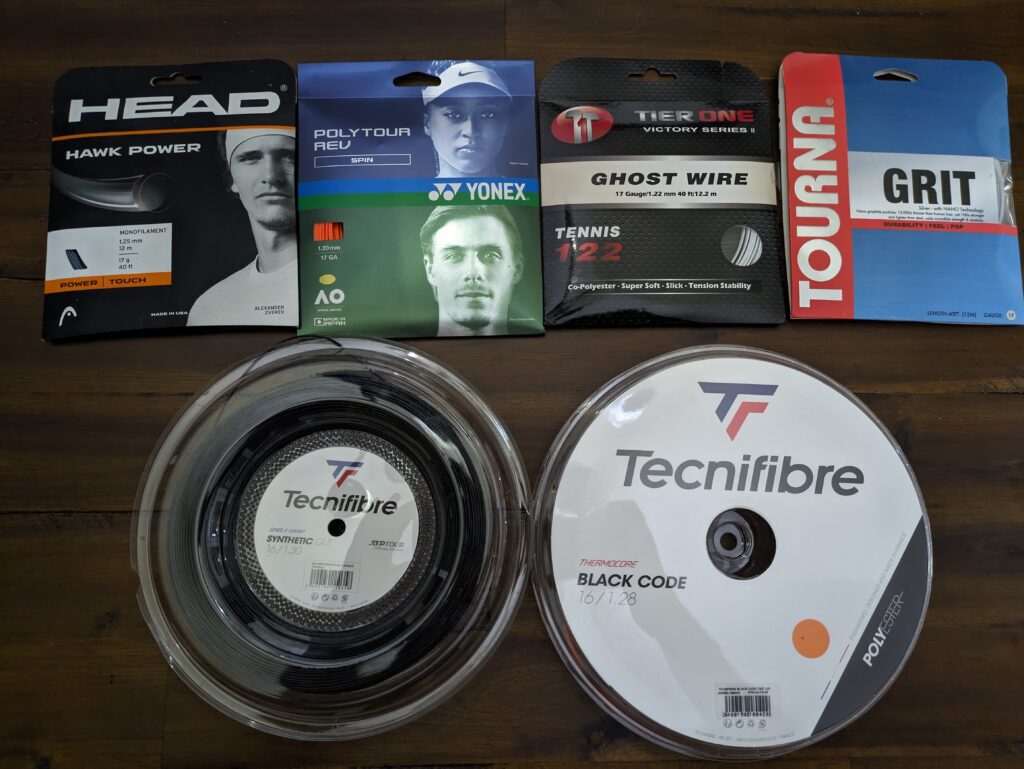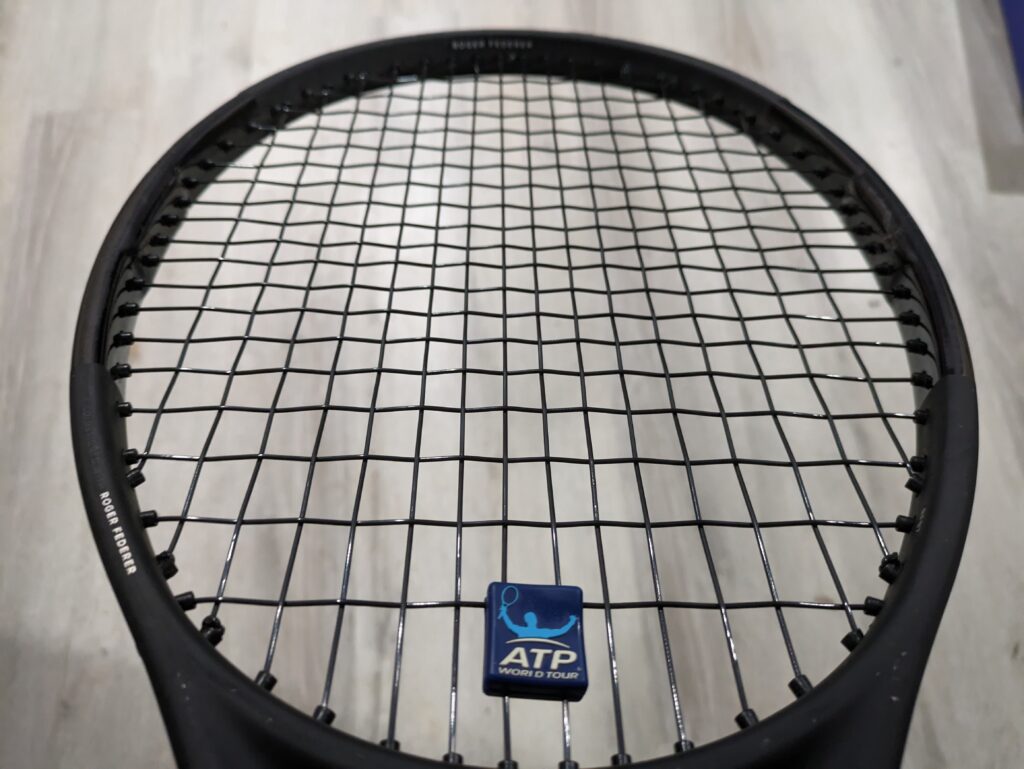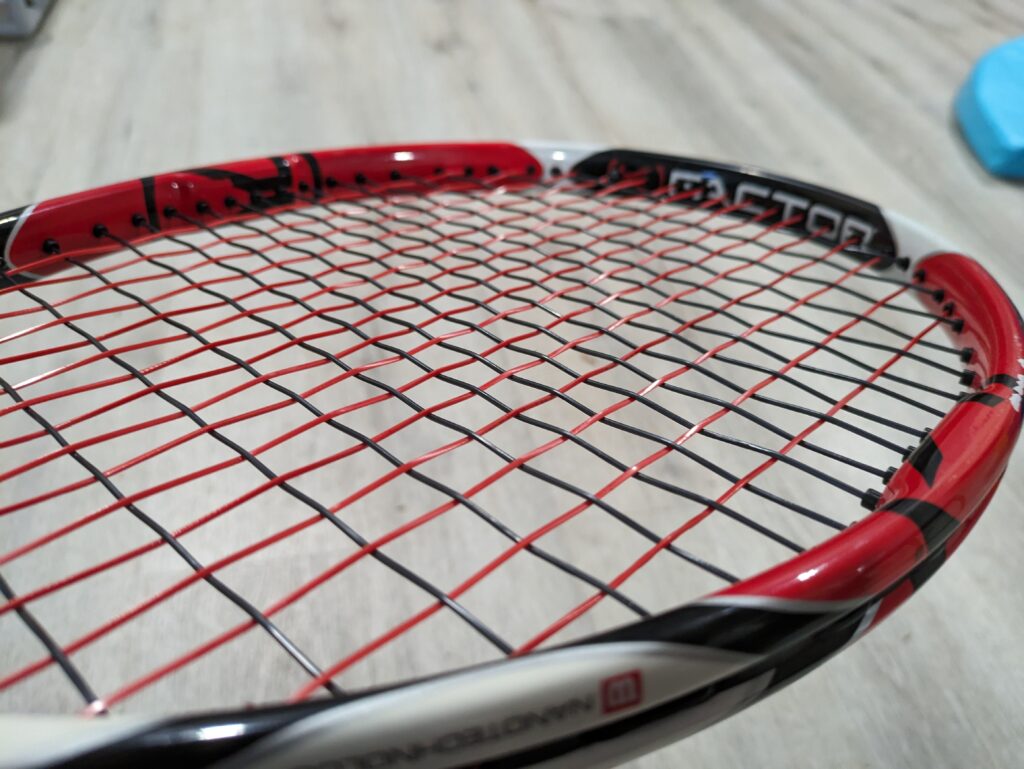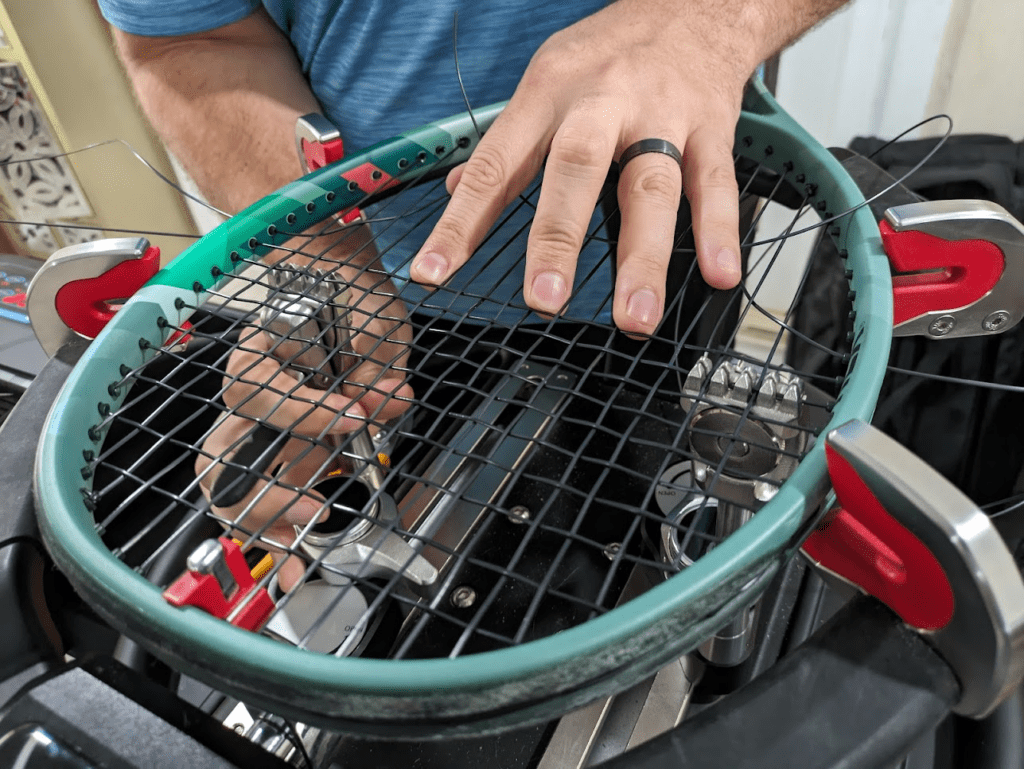There are many types of tennis strings. Below we will talk about all the different tennis string types and how they affect your racquet’s performance.
Some tennis players don’t put much thought into their strings, however, even the best tennis racquets won’t perform well without the right strings. Learning to customize your tennis racquet with different string types will help you get the most out of your ability.
What are the Different Types of Tennis Strings?
Most of the best tennis strings can fall into one of four categories.
- Natural gut: best for power and recovering from injury
- Multifilament: best for power without breaking the bank
- Synthetic gut: best for most beginners & intermediate players
- Polyester: best for advanced players who break strings often
Each category can have varying characteristics, so keep reading for a deeper dive into each tennis string type and how they change your racquet’s performance.

Table of the Different Tennis String Types
Below is a table that shows how the different tennis string types perform based on certain criteria.
- Durability refers to how long you can play with a string before it breaks
- Tension maintenance refers to how well the string resists loosening once installed in the racquet. All strings will immediately start losing tension immediately after being put in a racquet, but some strings maintain that tension better than others.
| Natural Gut | Multifilament | Synthetic Gut | Polyester | |
|---|---|---|---|---|
| Cost | $$$ | $$ | $ | $$ |
| Durability | Medium | Low | Medium | High |
| Tension Maintenance | High | Medium | Medium-Low | Low |
| Power | High | High | Medium | Low |
| Spin Potential | Medium | Low | Low | High |
| Control | Medium | Low | Medium | High |
Natural Gut are Powerful, Soft, & High-End Tennis Strings
Natural gut strings are the most expensive ones on the market due to being made from cow intestine fibers. They are the most powerful and the softest strings available. Natural gut strings also hold tension better than any other strings.
Multifilament Tennis Strings Offer Solid Power & Feel
Multifilament strings are composed of hundreds of fibers woven together. They are also soft and powerful, but not to the degree of natural gut. They aren’t as expensive as natural gut, but they also are less durable.
If you’re looking for power, you can also check out our list of best tennis racquets for power.
Synthetic Gut Strings are a Budget-Friendly Option for Most Players
Synthetic gut strings can vary quite a bit. They can be made of one or many fibers, and are the cheapest strings available. They hold tension moderately well, are middle of the road in terms of comfort/firmness, and have better durability than multifilament strings. They pair especially well with the best tennis racquets for beginners.
Polyester Strings Maximize Spin & Durability
Polyester (or co-poly) strings are the most common strings at the highest levels of tennis due to their high spin potential and durability. They generally fall between synthetic gut and multifilament strings in price. Poly strings are the most durable strings on the market, but they also have the shortest tension maintenance.

Poly strings vary in stiffness greatly but are still consistently the stiffest type of string. Due to their stiffness, they can be harsh on your elbow and/or wrist, so they should be avoided if you have any arm injuries. Poly strings are also unique in that, for optimal performance, they generally should be strung with a lower tension than normal and be restrung after roughly 15 hours of play, even if the strings haven’t broken.
We generally recommend players stay away from polyester strings until they’re ready to pair them with one of the best tennis racquets for advanced players.
What does String Gauge Mean?
String gauge represents the diameter or thickness of the string.
Similar to wire gauges, a lower gauge actually refers to a thicker string, while a higher gauge refers to a thinner string. Some strings will also have an “L” such as “16L gauge” which means it’s on the light (thin) side of 16 gauge, almost like saying 16.5 gauge.
- Thicker strings (lower gauge) provide more control and a lower launch angle. They also offer better tension maintenance and durability.
- Thinner strings (high gauge) will lose tension faster and break more easily. However, they proved better power and a higher launch angle which can help with net clearance.

How does a Tennis String’s Shape Affect its Performance?
A tennis string’s shape will add or reduce spin potential.
The fewer sides a string has (assuming it has sides and is not round), the greater the spin potential, but the lower the durability.
You might also find strings labeled as “rough.” Rough strings will have greater spin potential than their round counterparts and have the bonus side effect of being softer.
What are the Most Common Tennis String Shapes?
Some of the most common string shapes are circular, square, hexagonal (6 sides), and octagonal (8 sides). However, you can also find star-shaped strings and strings that are “rough”, still having a round profile, but with a surface that is rough rather than smooth.
For ultimate spin, pair a “rough” or other non-round string with one of the best tennis racquets for spin.
While racquets and strings definitely help spin production, nothing will make a bigger difference than your hitting technique. To improve your technique and get better spin production, check out some of the best tennis training aids.
What are Hybrid Tennis Strings?
Hybrid tennis strings are when you have one kind of string in the mains (going up and down) and a different type of string in the crosses (going side-to-side).

Stringing with a hybrid can help you combine the traits of two strings in an attempt to get the best of both worlds, such as the power of natural gut with the spin potential of polyester, or the soft response of a multifilament with the budget-friendliness of a synthetic gut.
Which Strings Should You Put in the Mains vs Crosses?
A good rule of thumb is that 70% of the performance will come from the string in the mains, while the remaining 30% will be driven by the crosses.

So, due to the inherent power and comfort of natural gut strings, a natural gut main/polyester cross hybrid will have more power and comfort than the same strings reversed (putting the polyester in the main and the natural gut in the crosses).
Hybrid stringing is a great tool, especially for intermediate players who may be having arm issues but don’t want to pay for a full bed of natural gut. It can also be used as the transition to the use of polyester strings. If you’re using one of the best tennis racquets for intermediate players and fall into one of those categories, give a hybrid setup a try.
At What Tension Should I String My Tennis Racquet?
When it comes to tension, most racquets have a recommended tension expressed as a range, somewhere between 45 and 65 pounds. You can find the recommended tension somewhere on the racquet, usually inside the throat (triangle) or along the frame.
- Lower tension will provide increased power (more depth on shots) while providing a softer stringbed.
- Higher tension provides increased control (less depth on shots) and a more firm response. You can also increase control by choosing one of the best tennis racquets for control.
One additional thing to keep in mind is that polyester strings are generally stiffer and should be strung at a lower tension.
When poly strings came out, most manufacturers recommended decreasing tension for them when compared to natural gut, synthetic gut, and multifilament strings. They will even encourage stringing below the racquet’s recommended tension range with polyester strings for some players. It has become increasingly common for poly strings to be installed in the 40-50 pound range on a racquet with a recommended tension of 50-60 pounds.

Finding the Best Tennis String Type for Your Game
Choosing the right tennis string for your game will depend on your skill level, playing style, physical fitness, and more. Here are some general rules I recommend.
- Beginners should start with a synthetic gut string. They are budget-friendly and durable so they don’t have to worry about their strings breaking.
- Competitive adults should look at a multifilament string. These strings will help add power to their game.
- Adults with tennis elbow (or other arm injuries) should string with natural gut. Gut strings provide the best comfort to heal from and prevent injuries.
- High-level adults should try polyester strings. Polyester (or poly) strings help provide spin and will be the most durable.
Now that you have a better understanding of the different tennis string types, check out our article on the 9 best tennis strings. You can also try experimenting with different tensions, gauges, and hybrid setups to find your ideal tennis string setup.
Remember that your string setup is only half of your tennis racquet experience. Take a look at the best overall tennis racquets to get the most out of your experience on court.

Thank you for the tips on the strings- I’m a beginner and didn’t know there was such a difference!
Thanks Katherine, let me know if you have any questions!
great info for a beginner and excellent, detailed breakdown.
Thanks Ethan, glad you enjoyed my breakdown!
the best comprehensive explanation about all aspects of strings, thanks for sharing your knowledge
Thanks Arnaldo, I’m glad you enjoyed it!